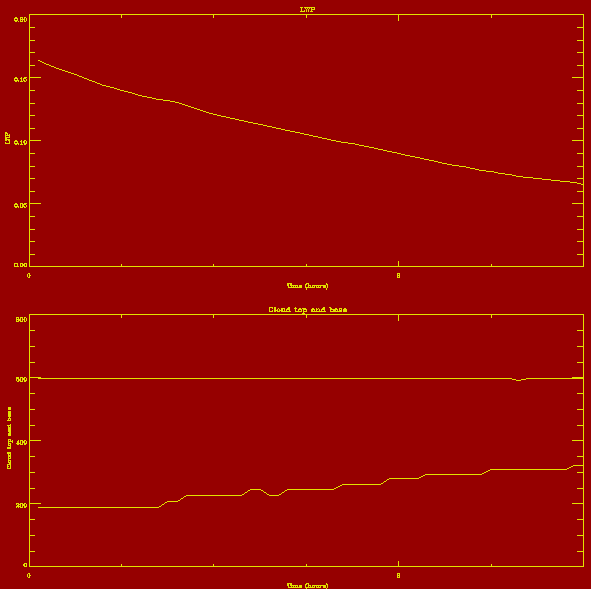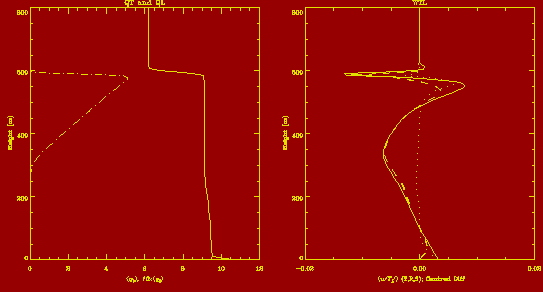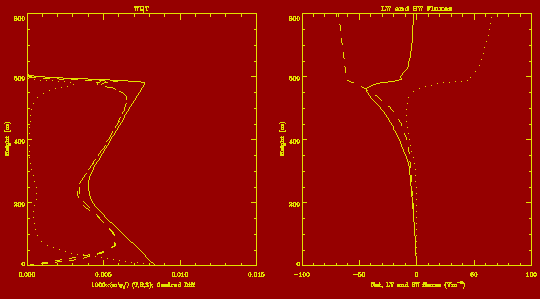|
Test Case 3: Fire stratocumulus
This test case is a 3 dimensional run which requires the radiation
code.
This page provides the background information on test case 3 and
examples of run of test case 3 on various machines.
Background information (from Jon Petch)
The extensive sheets of stratus and stratocumulus found on the eastern
side of ocean basins may have a strong influence of the planet's
climate. FIRE (First International satellite cloud climatology project
Regional Experiment) was an observational campaign designed to study
the stratocumulus sheets off the coast of California in some
detail. This case, which is based on the observations of Hignett
(1991, JAS) and similar to a EUROCS model
intercomparison, examines the impact of short-wave radiation on the
boundary layer dynamics and thence the cloud thickness.
Stratocumulus sheets are usually located at the top
of a mixed layer beneath a strong inversion. The cloud is maintained
by moist fluxes through this mixed layer. However, during the day,
short-wave radiation is absorbed by the cloud, warming the cloud layer and
decoupling it from the mixed layer below. This reduces the moist
fluxes into the cloud layer so that continued short-wave warming and
mixing with dry air from above the inversion cause the cloud to thin.
At nighttime, the cloud cools by
long-wave radiation and recouples with the mixed layer so that, with the
resumption of moisture fluxes into the cloud layer, the cloud thickens
again.
This case is initiated with a nocturnal stratocumulus sheet but at a
local time of 10am. Thus the thinning process due to the incident
solar radiation can be seen clearly over the three hour simulation in
the time-series of liquid water path, cloud base and cloud top
below. Some example flux profiles, averaged over the last three hours
of the run, are also shown.

Cloud timeseries.


Cloud, vapour and TL flux profiles.
Water vapour flux and radiative flux profiles.
This case is a good example of the use of the LEM with
non-precipitating moist processes and interactive radiation with high
vertical resolution.
Files required to run test case 3
The files needed to run this test case can be found in
/home/lem/VER2.3/TEST_CASES/TEST3_2.3 and the table below indicates
which files you'll need for which machines
|
Turing (T3E - no longer available) |
Department machines |
Origins (i.e. wren, fermat or green) |
Newton |
| run...f |
runTEST3_2.3.f |
runTEST3_2.3-m.f |
runTEST3_2.3-w.f |
runTEST3_2.3-w.f |
| end...f |
endTEST3_2.3.f |
endTEST3_2.3.f |
endTEST3_2.3.f |
endTEST3_2.3.f |
| nmlsetup... |
nmlsetupTEST3_2.3-t |
nmlsetupTEST3_2.3-m |
nmlsetupTEST3_2.3-w |
nmlsetupTEST3_2.3-w |
| nmlchain... |
nmlchainTEST3_2.3 |
nmlchainTEST3_2.3 |
nmlchainTEST3_2.3 |
nmlchainTEST3_2.3 |
| model... |
modelTEST3_2.3-t |
modelTEST3_2.3-m |
modelTEST3_2.3-w |
modelTEST3_2.3-n |
Runs for Test Case 3
| Computer |
Run No |
Version |
PEs |
IIP, JJP, KKP |
Time Taken |
Results |
| Newton |
126 |
2.3 |
10 |
80, 80, 100 |
4.50 hrs |
Cloud timeseries
Cloud, ... profiles
Water vapour, ... profiles
|
| Origins |
25 |
2.3 |
10 |
80, 80, 100 |
unknown |
Cloud timeseries
Cloud, ... profiles
Water vapour, ... profiles
|
| GRID |
55 |
2.3 |
1 |
32, 32, 100 |
117 hrs |
Cloud timeseries
Cloud, ... profiles
Water vapour, ... profiles
|
| T3E at Met Office |
N/A |
2.2 |
10 |
80, 80, 100 |
unknown |
Cloud timeseries
Cloud, ... profiles
Water vapour, ... profiles |
| Turing |
706 |
2.2 |
10 |
80, 80, 100 |
unknown |
Cloud timeseries
Cloud, ... profiles
Water vapour, ... profiles |
|



